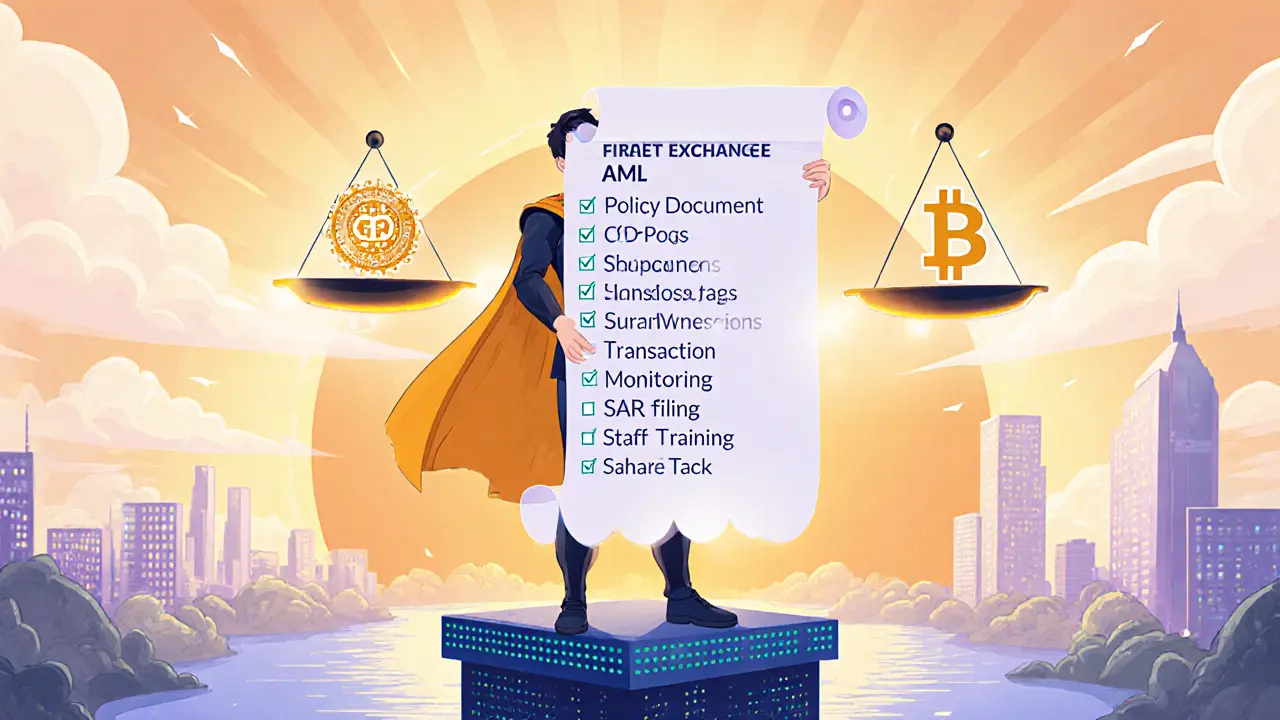Crypto Exchange AML Compliance Checker
Compliance Assessment Results
When regulators started treating digital asset platforms like traditional banks, crypto exchanges had to scramble for a way to stop criminals from laundering money. The result? A set of anti‑money laundering (AML) systems that blend legal mandates with cutting‑edge tech. Below is a plain‑English walk‑through of how a modern crypto exchange builds and runs its AML program.
Regulatory backdrop that forced AML on crypto
In 2019 three U.S. agencies - the Commodity Futures Trading Commission (CFTC), the Securities and Exchange Commission (SEC) and the Financial Crimes Enforcement Network (FinCEN) - issued a joint statement classifying crypto exchanges as financial institutions under the Bank Secrecy Act (BSA). That move ended the regulatory vacuum and made exchanges subject to the same AML rules that banks follow.
Internationally, the Financial Action Task Force (FATF) laid out three core AML categories for the sector: Know Your Customer (KYC), transaction monitoring, and suspicious activity reporting. Each category ties back to a legal requirement, whether it’s the EU’s 5AMLD, the U.S. BSA, or similar rules in Singapore, Japan or New Zealand.
The three AML pillars in practice
- Know Your Customer (KYC) - gather identity data, run sanctions and PEP checks, and assign a risk rating.
- Transaction monitoring - continuously scan on‑chain and off‑chain activity for patterns that look like layering or structuring.
- Reporting & remediation - reach out to customers, update records, and file Suspicious Activity Reports (SARs) to the relevant authority.
All three must work together; a weak link invites enforcement action.
Technical backbone: Customer Due Diligence and screening
Customer Due Diligence (CDD) is the data‑gathering stage. Exchanges collect government‑issued IDs, proof of address, and sometimes biometric data. The information feeds a risk engine that classifies users into low, medium or high risk. The risk engine then triggers a series of real‑time checks:
- Sanctions screening against global watchlists (OFAC, UN, EU).
- Politically Exposed Persons (PEP) detection, which flags anyone with a close relationship to a public official.
- Adverse media monitoring that scrapes news feeds for negative headlines tied to the customer’s name or wallet address.
- Phonetic and linguistic matching to catch variations in spelling or transliteration.
AI‑driven models then analyze the incoming data for inconsistencies-think a passport that doesn’t match a selfie, or a high‑risk jurisdiction paired with unusually large transaction volumes.
Real‑time transaction monitoring
Once a user is onboarded, the exchange’s monitoring engine watches every trade, deposit, withdrawal and internal transfer. Modern solutions score each event on attributes such as amount, frequency, counter‑party reputation, and velocity. Three typical compliance approaches are illustrated in the table below.
| Approach | Key Mechanism | Regulatory strictness | Typical use case |
|---|---|---|---|
| Allow‑list | Only pre‑approved, KYC‑verified wallet addresses may transact. | Very high - mimics traditional bank account opening. | High‑value institutional platforms. |
| Deny‑list | Block transactions that involve known illicit addresses (e.g., darknet UTXOs). | Moderate - relies on external illicit‑address databases. | Retail exchanges with high trade volume. |
| Hybrid risk scoring | Combine allow‑list, deny‑list, and behavior‑based analytics to assign a dynamic risk score. | Balanced - meets most regulator expectations. | Global exchanges serving multiple jurisdictions. |
Regardless of the approach, the engine must generate an alert when a score exceeds a predefined threshold, prompting the compliance team to investigate.

Global regulatory patchwork
Operating in more than one country means an exchange has to juggle overlapping rules. The EU’s 5AMLD requires a “travel rule” - sharing originator and beneficiary details for transfers above €1,000. The U.S. BSA imposes a $10,000 filing trigger for cash‑equivalent crypto transactions. Singapore’s MAS demands a “risk‑based” AML program that can be audited quarterly.
To stay compliant, most exchanges create a dedicated legal‑compliance unit that:
- Maps each jurisdiction’s AML obligations to internal policies.
- Maintains a master SAR filing calendar.
- Runs quarterly staff training on new guidance (e.g., FATF’s 2023 “Travel Rule” update).
Enforcement you can’t ignore
In 2021 a US‑based crypto derivatives platform settled for $100million after regulators found its AML program was “rudimentary” and missed dozens of high‑risk transactions. A separate case saw three founders each fined $10million for violating the BSA, with jail time hanging over their heads.
These examples prove that weak AML isn’t just a compliance cost - it’s a massive financial and reputational risk.
Building a scalable AML stack
Modern stacks combine low‑code orchestration with plug‑and‑play APIs from specialist providers. A typical workflow looks like this:
- User submits KYC docs → API call to identity‑verification vendor.
- Verification result feeds risk engine → assigns risk tier.
- Risk tier determines which monitoring rules apply (allow‑list, hybrid, or deny‑list).
- Every transaction triggers a webhook to the monitoring engine.
- Alert generated → case management system queues it for analyst review.
- Analyst decides: close, file SAR, or request additional info from the user.
Scalability is achieved by containerizing each component, auto‑scaling based on transaction volume, and using cloud‑based data lakes for historic analytics.
Checklist for a robust AML program
- Documented AML policy aligned with FATF Recommendation 10.
- Risk‑based CDD process covering identity, source of funds, and PEP status.
- Real‑time sanctions and adverse‑media screening against up‑to‑date watchlists.
- Dynamic transaction monitoring with adjustable risk thresholds.
- Dedicated SAR filing procedure with audit trails.
- Regular staff training and independent audits.
- Scalable tech stack (API‑first, cloud‑native, AI‑enhanced).
Follow the list and you’ll have a foundation that satisfies regulators in most major jurisdictions.
Mini‑FAQ

Frequently Asked Questions
Why do crypto exchanges need AML when transactions are on a public ledger?
Public ledgers show addresses, not identities. Exchanges act as the bridge between anonymous on‑chain activity and real‑world fiat or services, so they must verify who sits behind each address and stop illicit funds from flowing through their platform.
What’s the difference between an allow‑list and a deny‑list?
An allow‑list only permits transactions from pre‑approved, KYC‑verified wallets. A deny‑list blocks transactions that touch known illicit addresses. The former is stricter but can hurt user experience; the latter is more flexible but relies on external intelligence.
How often should an exchange update its sanctions screening?
Best practice is real‑time or at least daily updates. Many providers push new entries via API as soon as a watchlist changes, ensuring you never miss a new sanction.
What are the penalties for failing AML compliance?
Penalties range from hefty fines (up to $100million in the US) to revocation of banking licenses, and in severe cases, criminal charges against executives.
Can AI replace human analysts in AML monitoring?
AI excels at flagging anomalies and scoring risk, but final decisions-especially SAR filing-still need human judgment to meet regulatory standards.
With the right mix of policy, tech, and skilled staff, a crypto exchange AML program can keep criminals at bay while offering a smooth user experience. Stay alert, keep your risk models fresh, and remember that regulators will always be watching.












Katrinka Scribner
October 10, 2024 AT 01:45 AMWow, that was a deep dive! 😍 I love how you broke down the AML pillars-makes it super clear for newbies like me. 🙌 Just a heads‑up, the typo in "regulatarors" threw me off a bit but no biggie! 😂
Jacob Anderson
October 10, 2024 AT 04:31 AMOh great, another compliance checklist-because we all have endless time to read legalese. 🙄 If I wanted a bedtime story, I'd pick a novel, not a risk‑engine manual.
Oreoluwa Towoju
October 10, 2024 AT 07:18 AMNice summary! It’s helpful for anyone just starting out. The steps are clear and the bullet points keep it tidy. Keep sharing such concise guides.
Amie Wilensky
October 10, 2024 AT 10:05 AMThe exposition on AML in the crypto sector reads like a modern treatise on regulatory philosophy, and it warrants a measured, critical appraisal. One cannot ignore the inherent tension between the anarchic ethos of blockchain technology and the hierarchical imperatives of state‑mandated compliance. While the author enumerates the three pillars-KYC, transaction monitoring, SAR filing-with commendable clarity, the underlying assumption that technology alone can seal the compliance gap is overly optimistic. The reliance on API‑driven checks, though efficient, introduces a vector of systemic risk, as any outage in a third‑party watchlist provider could cripple the entire monitoring apparatus. Moreover, the discussion of allow‑list versus deny‑list approaches, while technically accurate, fails to address the user‑experience degradation that an overly strict allow‑list imposes on legitimate traders. In practice, a hybrid risk scoring model, as advocated, must balance computational tractability with the nuanced assessment of behavioural patterns-a non‑trivial engineering challenge. The article’s claim that AI can detect inconsistencies such as mismatched passport photos is intriguing, yet it glosses over the false‑positive rates that often plague biometric verification systems. Furthermore, the mention of real‑time sanctions updates is commendable, but the operational overhead of integrating daily feed changes into a live risk engine should not be underestimated. It is worth noting that the compliance landscape is not static; regulators routinely amend thresholds, as evidenced by the divergent $10,000 filing trigger in the United States versus the €1,000 travel rule in the European Union. Consequently, any AML stack must be architected for modularity, allowing swift incorporation of new rule sets without extensive code rewrites. The section on global regulatory patchwork rightly highlights jurisdictional overlap, but the lack of concrete examples-such as how a Singapore‑based exchange reconciles MAS requirements with FATF recommendations-leaves the reader yearning for more depth. From a governance perspective, the recommended quarterly audits are prudent, yet the article does not explore the auditability of AI‑driven risk scores, which remains a grey area in many jurisdictions. The enforcement anecdotes, while stark, could benefit from a broader analysis of how penalties affect market behaviour beyond the immediate financial impact. In sum, the guide furnishes a solid foundation, but the reader should remain vigilant to the evolving nature of both regulatory expectations and technological capabilities. A disciplined, iterative approach to AML-one that couples robust policy frameworks with adaptable, transparent technology-will ultimately safeguard both the exchange and its users. Thus, the piece serves as a valuable starting point, albeit one that demands continual refinement as the crypto ecosystem matures.
Charles Banks Jr.
October 10, 2024 AT 12:51 PMSo you think a hybrid model is the silver bullet? Sure, if you love juggling endless parameters while pretending everything's under control. It's like putting a Band‑Aid on a broken pipe-looks tidy but leaks eventually.
Ben Dwyer
October 10, 2024 AT 15:38 PMYour breakdown is solid and easy to follow.
Lindsay Miller
October 10, 2024 AT 18:25 PMI appreciate the simple language you used; it makes a complex topic accessible. The checklist at the end is especially useful for teams building new compliance processes. It feels supportive and encourages best practices. Thanks for sharing such a clear guide.
Waynne Kilian
October 10, 2024 AT 21:11 PMGreat job on covering the basics, and the tone feels welcoming. I noticed a few minor typo‑s but they don't distract much. The philosophical bits add a nice touch, showing the bigger picture of why AML matters.
Michael Wilkinson
October 10, 2024 AT 23:58 PMThis is a must‑read for anyone building a crypto platform; the aggressiveness of regulatory scrutiny demands a strong AML backbone. Your emphasis on modular tech stacks hits the nail on the head-no more monolithic nightmares. Keep pushing the standards higher!
Kate Nicholls
October 11, 2024 AT 02:45 AMThe article strikes a good balance between detail and readability, offering practical steps without overwhelming the reader. While it could dive deeper into jurisdictional nuances, it serves as a solid primer. Overall, a commendable effort.